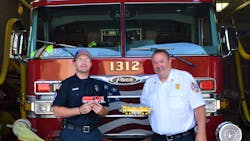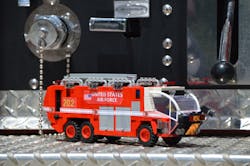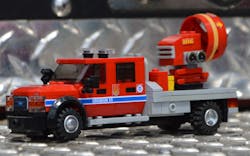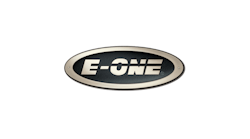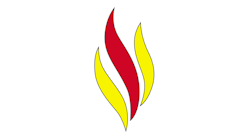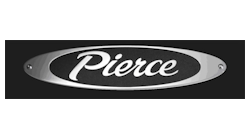Situated across the street from the World Trade Center, FDNY’s Ten House is the only fire station that was located inside of Ground Zero on the day of 9/11. The members of Ladder Company 10 and Engine Company 10 were the first to respond. The two companies lost five men that morning. Ladder 10, or “Ten Truck,” was found weeks later buried under 40 feet of rubble. Two second-hand apparatus served stints as replacements for Ten Truck from 2002 to 2013. In 2013, a new 100-foot rear-mount aerial was put into service as Ten Truck. From behind the crew cab to the rear bumper, the American flag is emblazoned on each side of the vehicle. In New York City, throughout the country and around the world, images of today’s Ten Truck remind members and civilians of the sacrifice that so many firefighters and their families made that day.
Ten Truck is meaningful, too, to Jeffrey Braun. The firefighter/EMT-B, who serves with the Lyons, IL, Fire Department (LFD) in a paid on-call role, learned from and follows in the footsteps of his father, who served with the Cicero, IL, Fire Department. That includes his father’s love of firehouse memorabilia. In fact, Braun is in the midst of creating a replica of Ten Truck. His medium: Lego bricks. Braun has built numerous apparatus on spec as well as for his personal enjoyment, to a degree that prompted several firefighters to describe his work as museum-grade, although he refrains from using that phrase himself. (Braun also constructs fire stations.) Sales are increasing, although his Ten Truck is for himself, at least at this point.Meticulous
Among the reasons that got Braun to thinking about the Ten Truck: That American flag artwork that’s on each side of the rig.
“My favorite part of building a vehicle is doing the decaling,” Braun says. The whole process of building replicas of fire apparatus is complicated: from designing a vehicle via the Lego Digital Designer software, to custom painting to exactly match a fire department’s color scheme, to configuring parts that are beyond the scope of blocks that can be purchased from Lego or third parties, such as BrickLink.com. However, “It’s those final touches of the decals and the lighting that stick out,” he explains. Braun’s replication of the graphics that are on apparatus is painstaking. “If I’m purchasing the vehicle, I would like the detail.”
Braun visits the websites of Pierce Manufacturing, E-ONE and Seagrave, among other apparatus manufacturers, as a means of zooming in on specific parts of vehicles: for example, the different types of pump panels or aerial devices that are utilized.
Over the past 10 years, Braun built hundreds of apparatus models. He charges $85–$90 for a normal fire engine and $120–$125 for larger, more complicated vehicles, such as tower ladders and aircraft rescue and fire fighting vehicles (ARFFs). Custom colors can increase the price of a replica.
“Pierce Manufacturing has its specific red, for example,” he explains. That said, Braun notes that many hues of bricks are available from stock for purchase from one source or another.
LFD Fire Chief Gordon Nord, Jr., purchased two of Braun’s replicas and displays them in his office at the firehouse. Visiting firefighters, including from neighboring Brookfield as well as Chicago, were enamored with the vehicles. The Brookfield crew commissioned Braun to build a replica of the department’s Truck 419 2001 E-ONE Hurricane rear-mount to present as a gift to a retiring officer. They snapped photos, including close ups, of each side.
“That’s quite an honor to me, to be involved in something like that,” Braun tells us.Not toying around
Braun teams up and brainstorms with several fellow Lego/fire apparatus aficionados domestically and around the world. Dieterich Herndobler, who is a firefighter/paramedic with the Lombard, IL, Fire Department, and Michael Parkinson, who is a civilian who lives in the Los Angeles area who gravitates to ambulances, are among collaborators with whom he works most closely.
Of his cooperative work with Herndobler, Braun remarks, “We talk about different types of windshields and the various compartments on vehicles and different types of apparatus nozzles for the water flow.”
The Lego Fire Community blog is one way that these artisans communicate and support each other’s endeavors and business.
Braun relishes the opportunities to connect with and get to know others who are in the fire service who he never would have met but for the interest that his replicas draw. “It kind of brings everybody together, which is particularly important with everything that’s going on in this world.”
Braun usually is working on two or three replicas at any given time. It typically takes him some 2–3 weeks to complete each vehicle. Depending on the apparatus and its variety of unique qualities, that translates into 30–40 hours per replica.
Of course, when LFD is busier, Braun’s opportunities to create and construct dwindle. In mid-May, Lyons firefighters used boats to rescue at least nine people after a branch of the Des Plaines River flooded neighborhoods following significantly heavy rainfall. “I was at the firehouse covering by myself,” he recalls. “We were running numerous calls. Ambulance calls. Additional flooding calls while other duty crews were out making rescues. It was a very hectic couple of days.”
When he sits himself down at his two workbenches in his makeshift workshop and in front of the dozens of bins of various shapes and colors of Lego blocks, Braun has an opportunity to try to leave the day’s work at the station/in the field behind—but not his love for the fire service.
“I’ve always loved the mutual-aid aspect of incidents and fire departments,” he says, “and I really wanted to incorporate that into my builds.”
Braun can be reached at [email protected].
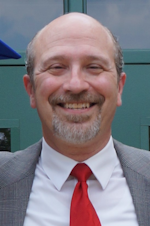
Rich Dzierwa | Managing Editor, Firehouse Magazine
Rich Dzierwa joined Firehouse Magazine in 2019 after four tenures with other publications. He was editor-in-chief of Consumers Digest/ConsumersDigest.com and of trade magazine Cutting Tool Engineering. He served as the consumer products reporter for BridgeNews and began his publishing career with an 11-year tenure at Appliance magazine, where he rose to managing editor after serving in other roles. Dzierwa's experience with consumer products, including furnishings, appliances, electronics and space design, has transferred to his Firehouse work regarding the magazine's Station Design columns and the Station Design Awards. Previous work also has contributed to his supervision of several surveys of fire service/EMS members, to produce unique reporting for Firehouse's audience. Dzierwa earned a bachelor's degree in English from Columbia College Chicago.
